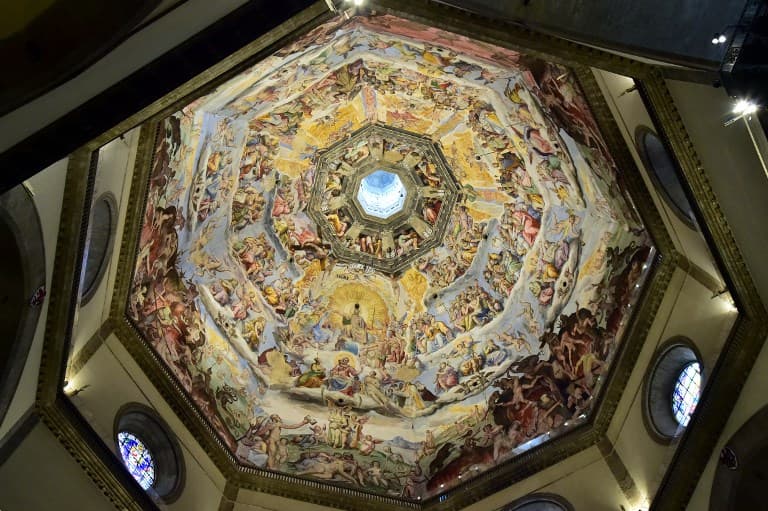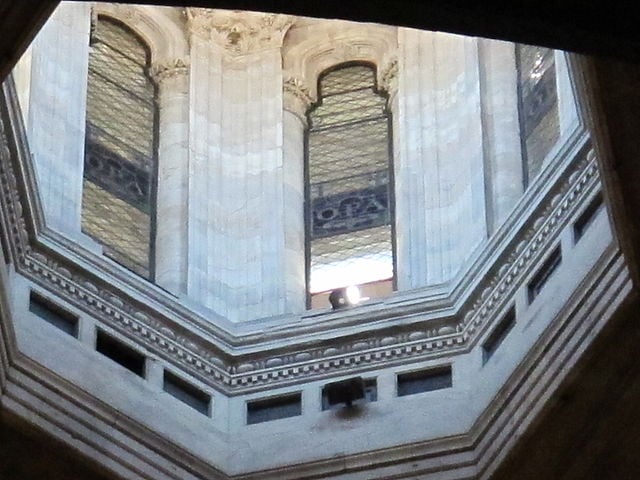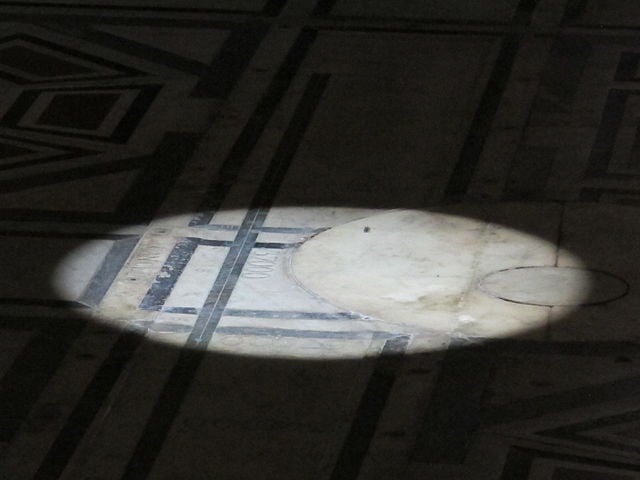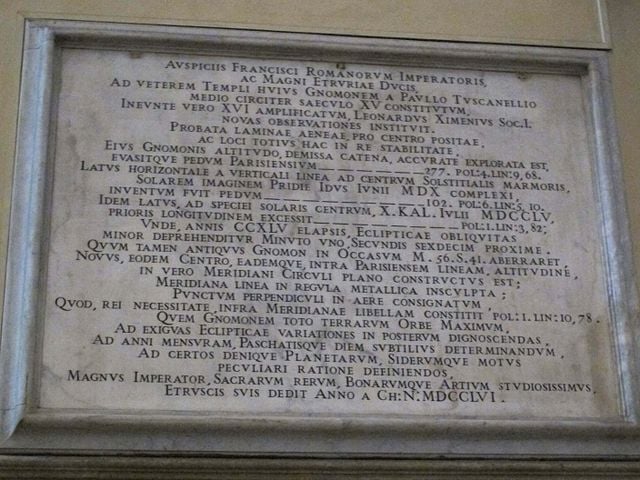One of Florence's greatest spectacles is about to begin

Each June, Florence Cathedral hosts a unique demonstration of nature's precision matched by human engineering: the passage of the midday sun through a gnomon set into the mighty dome.
Unnoticed by visitors for most of the year, the Duomo's gnomon – a device that tells the time of day or year by the way the sun strikes it – comes into its own between late May and July each year.
The instrument itself is hard to spot: located just over 90 metres up, just beneath the windowed lantern at the top of the dome, it looks like a small bronze shelf jutting out from the southern wall.

Photo: Sailko, CC BY-SA 3.0, Wikimedia
More easily identified is the brass meridian line running across the floor of the Chapel of the Cross, accompanied by an inlaid circle.
But what's it for?
That question is answered at midday on June 21st, the date of the summer solstice when the sun is at its highest point in the sky. It's then that light hits the gnomon, which has a round hole in its centre, and is projected along the meridian and onto the circle, which matches it perfectly in size.
 Photo: Sailko, CC BY-SA 3.0, Wikimedia
Photo: Sailko, CC BY-SA 3.0, Wikimedia
The device is what's known as a pinhole gnomon, which means that instead of casting a shadow the way the simplest sundials do, it projects a circle of light – a miniature image of the sun.
This image moves with the real sun across the sky (or rather, with the earth as it rotates and makes the sun appear to be travelling). It can be seen sliding down the walls of the cathedral and across the floor for several weeks when the sun is near its highest, though the solstice is when the alignment is at its best.
READ ALSO:
-
Everything you need to know about Calcio Storico, Italy's most violent tradition
-
Secret Michelangelo room in Florence to open to public
-
Leonardo Da Vinci's Codex Leicester to return to Italy
One of the highest placed gnomons in the world, the spectacle it produces is considered one of the most impressive (you can find smaller versions in San Petronio in Bologna and Santa Maria degli Angeli e dei Martiri in Rome).
It's even more so when you consider that it was built more than 500 years ago. The Florentine mathematician Paolo Toscanelli is thought to have first placed the gnomon in the Duomo in 1475, while the Sicilian astronomer and Jesuit Leonardo Ximenes laid the meridian you see today in 1756.
It was designed partly so that "the measure of the year and the date of Easter be more accurately determined", according to the inscription still visible on the wall near the choir: a valuable tool in the days when the most accurate way of measuring time was by observing the sun.

Photo: Sailko, CC BY-SA 3.0, Wikimedia
Pre-telescopes, early astronomers also used it to study rarer events like sunspots, eclipses or the passage of Venus between sun and earth. Ximenes took careful measurements over several years to determine whether earth's axis of rotation was shifting, from which he concluded (correctly) that it was.
Today the gnomon no longer serves a scientific purpose, but remains a fascinating sight. The disc of light travels at around 7 centimetres per second across the glorious backdrop of the cathedral for roughly 30 minutes around 1 pm (which during summer daylight saving time is when "true", solar noon falls).
Every year the cathedral invites guests to watch, with commentary from a guide, on several dates when the spectacle is at its best: in 2019, that will be June 11th, 14th, 18th and of course, the 21st.
You'll need to reserve by email ahead of time and arrive early to get a good seat. On the 18th, the commentary will be in English and in every case, entry is free. Find full details on the cathedral's website.
If you can't make it in person – or if you just can't wait – here's a video of the show.
This is an updated version of an article first published in June 2018.
Comments
See Also
Unnoticed by visitors for most of the year, the Duomo's gnomon – a device that tells the time of day or year by the way the sun strikes it – comes into its own between late May and July each year.
The instrument itself is hard to spot: located just over 90 metres up, just beneath the windowed lantern at the top of the dome, it looks like a small bronze shelf jutting out from the southern wall.

Photo: Sailko, CC BY-SA 3.0, Wikimedia
More easily identified is the brass meridian line running across the floor of the Chapel of the Cross, accompanied by an inlaid circle.
But what's it for?
That question is answered at midday on June 21st, the date of the summer solstice when the sun is at its highest point in the sky. It's then that light hits the gnomon, which has a round hole in its centre, and is projected along the meridian and onto the circle, which matches it perfectly in size.
 Photo: Sailko, CC BY-SA 3.0, Wikimedia
Photo: Sailko, CC BY-SA 3.0, Wikimedia
The device is what's known as a pinhole gnomon, which means that instead of casting a shadow the way the simplest sundials do, it projects a circle of light – a miniature image of the sun.
This image moves with the real sun across the sky (or rather, with the earth as it rotates and makes the sun appear to be travelling). It can be seen sliding down the walls of the cathedral and across the floor for several weeks when the sun is near its highest, though the solstice is when the alignment is at its best.
READ ALSO:
- Everything you need to know about Calcio Storico, Italy's most violent tradition
- Secret Michelangelo room in Florence to open to public
- Leonardo Da Vinci's Codex Leicester to return to Italy
One of the highest placed gnomons in the world, the spectacle it produces is considered one of the most impressive (you can find smaller versions in San Petronio in Bologna and Santa Maria degli Angeli e dei Martiri in Rome).
It's even more so when you consider that it was built more than 500 years ago. The Florentine mathematician Paolo Toscanelli is thought to have first placed the gnomon in the Duomo in 1475, while the Sicilian astronomer and Jesuit Leonardo Ximenes laid the meridian you see today in 1756.
It was designed partly so that "the measure of the year and the date of Easter be more accurately determined", according to the inscription still visible on the wall near the choir: a valuable tool in the days when the most accurate way of measuring time was by observing the sun.

Photo: Sailko, CC BY-SA 3.0, Wikimedia
Pre-telescopes, early astronomers also used it to study rarer events like sunspots, eclipses or the passage of Venus between sun and earth. Ximenes took careful measurements over several years to determine whether earth's axis of rotation was shifting, from which he concluded (correctly) that it was.
Today the gnomon no longer serves a scientific purpose, but remains a fascinating sight. The disc of light travels at around 7 centimetres per second across the glorious backdrop of the cathedral for roughly 30 minutes around 1 pm (which during summer daylight saving time is when "true", solar noon falls).
Every year the cathedral invites guests to watch, with commentary from a guide, on several dates when the spectacle is at its best: in 2019, that will be June 11th, 14th, 18th and of course, the 21st.
You'll need to reserve by email ahead of time and arrive early to get a good seat. On the 18th, the commentary will be in English and in every case, entry is free. Find full details on the cathedral's website.
If you can't make it in person – or if you just can't wait – here's a video of the show.
Join the conversation in our comments section below. Share your own views and experience and if you have a question or suggestion for our journalists then email us at [email protected].
Please keep comments civil, constructive and on topic – and make sure to read our terms of use before getting involved.
Please log in here to leave a comment.